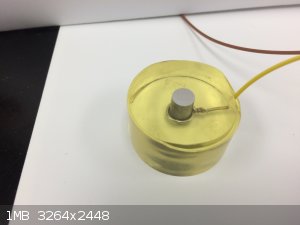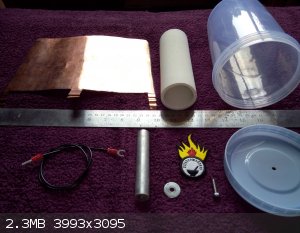Sulaiman
International Hazard
    
Posts: 3695
Registered: 8-2-2015
Location: 3rd rock from the sun
Member Is Offline
|
|
Platinum foil suggestions needed
I have a side-project that I would like to get right first time, so I would appreciate any input;
Santa sent me 5x (80mm x 80mm x 233nm) Pt transfer foils
that I want to make one or two electrodes with,
for general aqueous electrochemistry.
(optionally as a catalyst would be nice)
I suspect only at low current density, but that is OK for my purposes.
So I need a substrate.
stuff that I have available and may be suitable;
. glass tubing of various diameters
. glass sheet
. graphite rods, various diameters
. graphite foil, 0.4mm thick
. lead sheet, 2mm thick
. titanium, 2.2 x 45 x 80 mm
I favour the electrically conductive options as it may help with current paths,
but glass would be electrochemically 'inert' in the case of errosion of the Pt,
In any case, I have never 'gilded' anything so if anyone has advice on
the substrate or giliding techniques please give suggestions.
[Edited on 3-1-2017 by Sulaiman]
CAUTION : Hobby Chemist, not Professional or even Amateur
|
|
|
WGTR
National Hazard
   
Posts: 971
Registered: 29-9-2013
Location: Online
Member Is Offline
Mood: Outline
|
|
I routinely attach copper wires to various metals, pot them into epoxy, cross-section, and then polish them for electrochemistry.

In the picture above, it may not be obvious, but the electrical connections are completely sealed in epoxy. The only thing exposed is the flat
surface of steel, in this case. For for room temperature work I'd use a copper substrate, and then attach the platinum foil with silver conductive
epoxy. The platinum would have to be sealed around the edges with more epoxy, to protect the substrate. If doing it this way, make sure that all
your materials are compatible with whatever chemicals are being used. Epoxy may shrink or dissolve slightly in contact with certain chemicals, for
example. The silver conductive epoxy should have somewhat low viscosity for this application, I think, since the film is so impossibly thin.
I'm sure there are other ways to do it, this is my idea. I've never worked with such thin films before, as a disclaimer.
|
|
|
Sulaiman
International Hazard
    
Posts: 3695
Registered: 8-2-2015
Location: 3rd rock from the sun
Member Is Offline
|
|
I have a little electrically conductive silver ink that may work both for electrically connecting wires and adhering the Pt to a substrate,
but I'm not keen on incorporating silver as it easily ionises,
and pinholes in the Pt are inevitable.
Epoxy resin seems like a good choice for an insulator for seams in the Pt,
or maybe hot melt glue.
EDIT ; for rods (magnesium here) ring crimps and screws give a reliable connection

[Edited on 3-1-2017 by Sulaiman]
CAUTION : Hobby Chemist, not Professional or even Amateur
|
|
|
phlogiston
International Hazard
    
Posts: 1379
Registered: 26-4-2008
Location: Neon Thorium Erbium Lanthanum Neodymium Sulphur
Member Is Offline
Mood: pyrophoric
|
|
You don’t state your intended goal, but if you were planning to use these in chlorate or perchlorate cells it would be better to avoid epoxy, hot
melt and silver paint. They will fail when exposed to the electrolyte. Also, your foil is very thin. I believe the thickness of the Pt coating on
commercial Platinized titanium anodes is of the order of a few micrometers.
-----
"If a rocket goes up, who cares where it comes down, that's not my concern said Wernher von Braun" - Tom Lehrer |
|
|
Sulaiman
International Hazard
    
Posts: 3695
Registered: 8-2-2015
Location: 3rd rock from the sun
Member Is Offline
|
|
I only intend to do gentle electrochemistry, electrode potentials, mild electrolysis.
I did not imagine that a sheet of Pt only 1500 atoms thick would be useful for a chlorate cell 
I tend to over-engineer stuff, the cell I showed above was designed for a 100 uA load !
EDIT : No it did not perform as expected.
The theory was so simple and obvious, trivial really ... in theory.
On long term hold pending some electrochemical experiments that would benefit from a platinum electrode 
[Edited on 3-1-2017 by Sulaiman]
CAUTION : Hobby Chemist, not Professional or even Amateur
|
|
|
Fleaker
International Hazard
    
Posts: 1252
Registered: 19-6-2005
Member Is Offline
Mood: nucleophilic
|
|
Perhaps way more valuable as that foil to the right people than even 0.1 mm Pt sheet!
Neither flask nor beaker.
"Kid, you don't even know just what you don't know. "
--The Dark Lord Sauron
|
|
|
Morgan
International Hazard
    
Posts: 1694
Registered: 28-12-2010
Member Is Offline
Mood: No Mood
|
|
I wonder if the thinnest foils could spontaneously start glowing red hot in hydrogen/air or methanol/air environments?
[Edited on 17-1-2017 by Morgan]
|
|
|
Sulaiman
International Hazard
    
Posts: 3695
Registered: 8-2-2015
Location: 3rd rock from the sun
Member Is Offline
|
|
the foils that I have are 'transfer' foils, lightly adhered to a paper backing, making transfer to objects easier,
but I do not think I could get a manageable foil.
These may be more appropriate
http://www.ebay.co.uk/itm/Zinc-Alloy-Hand-Warmer-Filler-Cup-...
http://www.ebay.co.uk/itm/3-X-REPLACEMENT-CATALYST-PADS-FOR-...
CAUTION : Hobby Chemist, not Professional or even Amateur
|
|
|
Morgan
International Hazard
    
Posts: 1694
Registered: 28-12-2010
Member Is Offline
Mood: No Mood
|
|
I was just wondering if a bit of wispy foil held or dropped into say an Erlenmeyer flask with methanol vapor if it would have enough surface area to
activate. I can imagine foil that thin is hard to manage. I've a spool of .002ths Pt wire and even something as "large" as that is hard to see if you
accidentally drop a piece of it.
This wick of mine from a hand warmer does spontaneously warm if misted with methanol but I was just curious about an ultra thin foil. Do you know how
your foil is made, the technical aspects?
https://www.youtube.com/watch?v=UtkEfzpZ4Sg
|
|
|